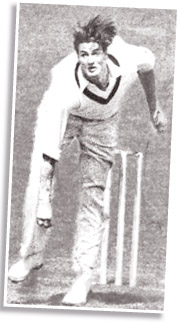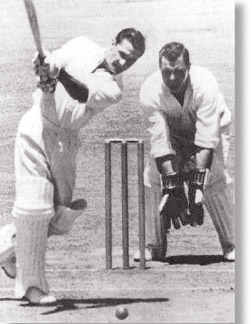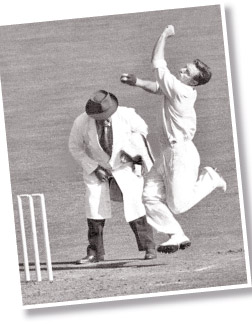Don Bradmanís unbeaten 1948 team-the greatest!
By A.C.De Silva
Lankans played against Bradman
|

Sir Donald Bradman - A shrewd cricketing head. Captain of
the Australian team in 1948 on tour of England. (AFP) |
The mere mention of Bradmanís name in any nook and corner of a
household associated with cricket here in Sri Lanka will undoubtedly
raise some interest. The interest will be because of the fact that the
great Australian batsman also played here in Sri Lanka in 1948 as the
captain of the team in a whistle-stop match against Ceylon captained by
M. Sathasivam.
Australia who batted first on that occasion, made 184 for 8 wickets
declared with Barnes making 49 retd. Miller 46 and Loxton 29. Sathi
Coomaraswamy was the pick of the Ceylon bowlers with 4 for 45 and R.L.
de Kretser 2 for 39.
Ceylon was 46 for 2 wickets when rain put a stop to the match.
The Ceylon team was captained by M. Sathasivam. Some of the other Sri
Lanka players were: S. Nagendra, Sargo Jayawickrema, Bertie Wijesinghe,
C.I.Gunasekera, Allen and B.R. Heyn. A note of interest is that Bertie
Wijesinha is still among the living.
Former famous Australian cricketer and writer Fingleton was here and
he praised the Ceylonese side for their fielding.
|

Keith Miller - One of the best all-rounders of all time.
(AFP) |
CRICKET: What was the greatest allround team to tour England?
On record the 1948 Australian team under Sir Donald Bradman was the
greatest allround team to tour England. He was a shrewd cricketing head.
Opinions will always differ on whether it was stronger than Warwick
Armstrongís great team of 1921, but if one goes by records, Bradmanís
team was triumphant. It never knew defeat whereas Armstrongís great side
went down to a side organised towards the end of the tour by Archie
McLaren.
Bradmanís team, therefore, remains pre-eminent in the scorebooks.
Like Armstrongís, it benefited by coming after a World War. The AIF
team, under Herbie Collins, provided the nucleus of the Australian team
for a decade and more after the war. Men like Pellew, Gregory, Oldfield,
Taylor and others stood high in Australian cricket annals.
Charlie Macartney at first played with that AIF in England after the
war but Charlie was anxious to get home after the mud of France and Ted
McDonald was another who came to re-inforce the ranks of the cricketing
soldiers, as did Armstrong himself.
It is purely a matter for speculation how the warriors of Bradman
would have fared against those of Armstrong. Such things can only be
conjectured but, knowing the batsmen of 1948 as well as Jack Fingleton
did (he played with many of them) there is no doubt that Jack Gregory
and Ted McDonald, with their thunderbolts, would have given a lot of
worry for many batsmen of 1948.
A few were none too keen on bouncers although it was felt that the
spin of Mailey, Armstrong and Macartney would not have bothered unduly
Bradmanís batsmen.
They were much too fleet of foot, particularly the Don though at 40
his great days of wizardry were past.
|

Neil Harvey - The glorious year saw the emergence of a
19-year-old giant. (AFP) |
Hasset, the teamís Vice-Captain and Miller, one of the best
allrounders of all time, came from the Australian Services team that
played good cricket in England after the Second War, Men like Arthur
Morris and Ray Lindwall were in the services in the islands war against
Japan and Bradman, Barnes, Brown, Johnson (Ian), Don Tallon, a great
Ďkeeperí and Toshack were around before the war in Australia.
One who came from the obscurity in Australia and to the very top was
Bill Johnston, the Victorian left-hand speedster, who was as good a
left-hander as seen by many. He could bowl swingers and could turn, if
needed, to spinners. Additionally, Bill was one of the best players on
tour.
England in sore plight
The Australians of 1948 met England when it was in a sore plight. The
Bombing devastation of the war was on all sides and rationed and the
poor food did not make for vitamins in the countryís cricket.
What affected the cricket of the country most and played into the
Australian hands was the rule that enabled the Australians to take a new
ball at the end of 55 overs. It seemed to be made to order for Bradmanís
men.
Lindwall, and it is doubtful that the world has ever known a more a
skilful and artful fast bowler and Keith Miller, had barely put on their
sweaters after the first new ball than they seemed to be getting ready
for the second.
|

Ray Lindwall - The world has never known a more beautiful or
artful fast bowler. (AFP) |
There was no respite for the poor English batsmen and when the two
champions were being spied, Bill Johnston came on to worry the life out
of the men at the crease.
And to this when Toshak was added with his nagging deliveries on or
outside the leg stump, and the Australian bowling was rarely mastered.
The side had two capable slow leg-break bowlers in Doug Ring and Col.
McCool but the final Test at the Oval was the only Test that they had
between them. The constant new ball made them redundant and Bradman, as
shrewd a cricketing head as ever led an Australian team, was not lightly
tossing side the rich gift of a new ball every 55 overs presented to him
by the English legislators.
On his last of four playing tours, Bradman was accepted like royalty
whenever he played. His final appearance at Lordís when thousands
gathered on the field and hoped for a final glimpse of him on the
Australian balcony.
He didnít come out. He had played his last innings at Lordís and left
it at that.
Bradman - merciless
So there it was, Don Bradman who aimed to get an unbeaten record on
the tour, which had never been done before by an Australian team, and
when he set his mind on something he was merciless, leaving nothing to
chance. He was also a captain well above the ordinary, thinking quickly
and clearly. Bradman and his wonderful team of 1948 carried too many
guns for the English, hard hit as they were by war.
Dennis Compton played several truly great innings, pulling and
hooking ferociously, the many bouncers hurled by Miller and Lindwall.
Bradman, himself, hit two splendid centuries and finished his Test
career at the Oval when he was bowled by Eric Hollies for a duck.
Hassett scored well, as did Arthur Morris, but the giant of years to
come was the then 19-year-old Neil Harvey who made a great century in
his first Test at Headingley and was with Bradman when the massive
target of 404 for 4, shorn of time Yardley batting on the last day was
achieved. Bradman sent Harvey in ahead of him to the pavilion when the
game ended.
The real old-timers have said that the 1909 Australian team to
England held all the trumps, many are of the view that Armstrong who led
the side had many victories, but one thing Don Bradmanís team has the
record - unbeaten. |

